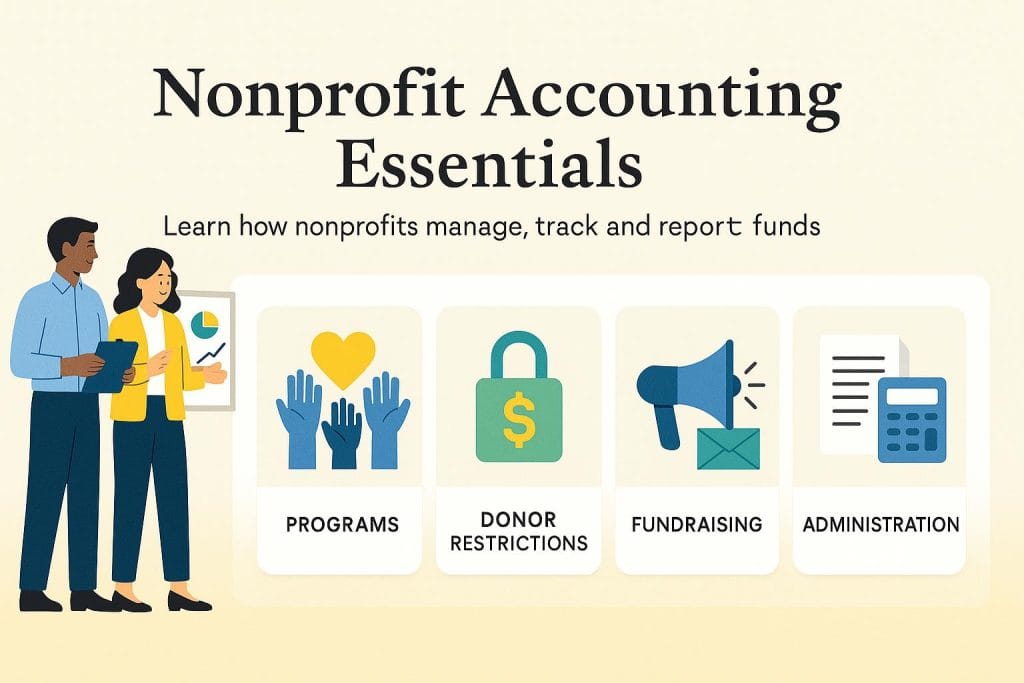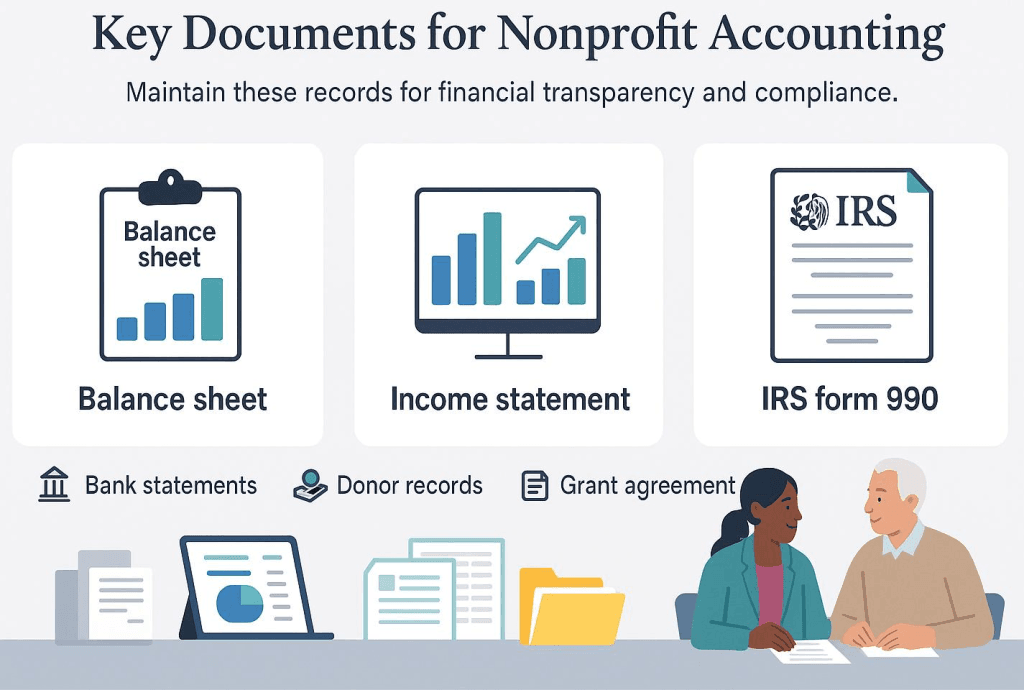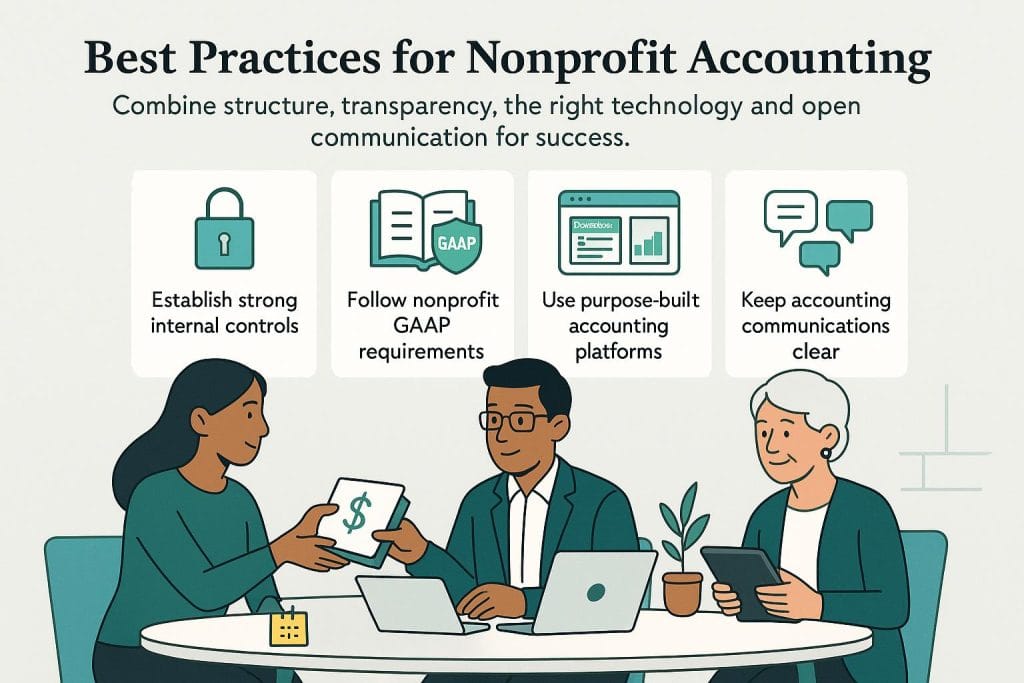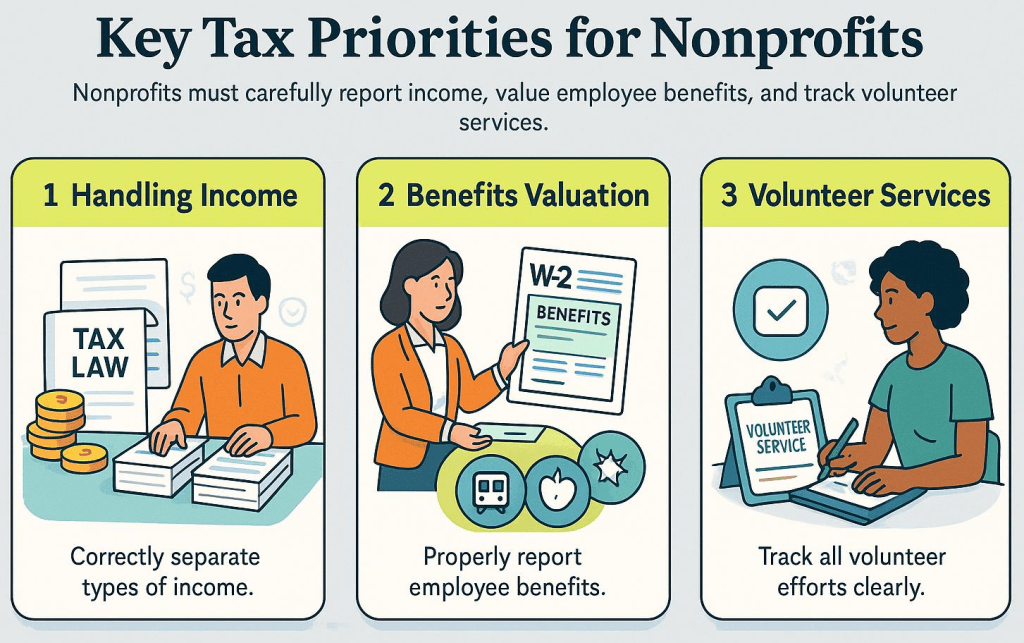Business.com aims to help business owners make informed decisions to support and grow their companies. We research and recommend products and services suitable for various business types, investing thousands of hours each year in this process.
As a business, we need to generate revenue to sustain our content. We have financial relationships with some companies we cover, earning commissions when readers purchase from our partners or share information about their needs. These relationships do not dictate our advice and recommendations. Our editorial team independently evaluates and recommends products and services based on their research and expertise. Learn more about our process and partners here.
Nonprofit Accounting: A Complete Guide to Accounting for Nonprofits
Accounting for a nonprofit organization can be complex. This guide will help you stay on top of your nonprofit accounting responsibilities.

Table of Contents
If you have a nonprofit organization, working toward making the world a better place is likely your top priority. However, nonprofits receive generous tax breaks and must be accountable to their donors. So, it’s also of the utmost importance to ensure you properly account for and report your incoming and outgoing money.
Nonprofit accounting provides financial transparency that makes donors feel comfortable and assured that the organization is spending money wisely to further its goals. Additionally, sloppy or inaccurate accounting can lead to problems with the IRS, like possibly losing nonprofit status, receiving hefty fines and even being hit with criminal charges. This guide will help nonprofits improve their accounting skills, learn how to handle accounting challenges unique to accounting for nonprofits and remain compliant.
What is nonprofit accounting?

Nonprofit accounting is a system of financial management, recordkeeping and reporting for not-for-profit groups. Nonprofits are organizations that:
- Operate for purposes that benefit the public rather than to earn profit for owners or shareholders.
- Are exempt from paying income taxes under IRS Code Section 501(c)(3) and related provisions.
- Must comply with specialized accounting standards under Financial Accounting Standards Board (FASB) Topic 958.
Nonprofit accounting uses specific language and designations to note funded activities and create reports to show donors how their money is being used. Under FASB Accounting Standards Update (ASU) 2016-14, Not-for-Profit Entities (Topic 958): Presentation of Financial Statements of Not-for-Profit Entities, organizations must classify net assets into two primary categories:
- Net assets without donor restrictions: Funds that can be used for any purpose that supports the organization’s mission
- Net assets with donor restrictions: Funds that are limited by donor-imposed restrictions, either temporarily (for specific purposes or time periods) or permanently (such as endowments)
Nonprofit accounting uses specific language and designations to note funded activities and create reports to show donors how their money is being used. Here are a few examples:
- Programs: The services a nonprofit provides are called programs. Each program generally has its own revenue, expenses and records.
- Donor restrictions: Some donors restrict their contributions to specific purposes or programs. Nonprofits must account for these restrictions in their financial management. Funds not donor-restricted can be used for any program, administrative costs or other purposes.
- Fundraising: Fundraising denotes activities that raise an organization’s profile or solicit donations. These activities can include direct mail campaigns, email newsletters and charity fundraising events.
- Administration: Funds for managing a nonprofit are called administration or overhead funds. These funds are necessary to keep the nonprofit operating; they must be noted in all accounting and reported to donors. Donors generally prefer that nonprofits keep their overhead costs, such as salaries, as low as possible to direct most funds toward programs.
According to Eileen Gwaltney, a certified public accountant with over 20 years of experience in the field, one of the biggest accounting mistakes nonprofit organizations can make is improperly allocating administration expenses. Good nonprofit financial management should ensure that the organization can function and grow. However, donors might hesitate to give if your functional expenses become too large.
“With donors focused on making the most of their contribution, it is important for nonprofits to allocate costs correctly,” Gwaltney explained.
Nonprofit accounting vs. nonprofit bookkeeping
Nonprofit organizations rely on bookkeeping and accounting best practices to maintain compliance. While these terms are often used interchangeably, they encompass distinct functions within financial management.
- Nonprofit bookkeeping: Nonprofit bookkeeping involves recording day-to-day financial transactions, such as donations, grants, expenses, payroll and any other financial activity. It ensures the organization has a clear and organized record of its financial inflows and outflows.
- Nonprofit accounting: In contrast, nonprofit accounting takes a broader view, focusing on the bigger financial picture and its strategic implications. Accountants leverage the data bookkeepers provide to prepare financial statements like balance sheets, income statements and cash flow statements. Additionally, they ensure compliance with nonprofit-specific accounting standards like FASB ASC 958. These practices ensure that the organization’s financial reporting is accurate and reliable.
What is the difference between accounting for nonprofits and regular business accounting?
Nonprofit accounting differs in several ways from traditional small business accounting. Both nonprofit and for-profit organizations must produce regular reports detailing their financial activities and use many of the same accounting principles. However, their different goals result in significant differences in these reports. See how accounting for nonprofits compares to accounting for for-profit enterprises in the chart below:
Aspect | Nonprofit | For-Profit |
|---|---|---|
Primary organizational focus | Mission achievement and stewardship | Profit generation and shareholder value |
Net assets classification | With/without donor restrictions | Owner’s equity and retained earnings |
Revenue recognition | Contributions vs. exchange transactions | Sales and service revenue |
Functional expense reporting | Program, administration, fundraising | Cost of goods sold, operating expenses |
Tax status | Tax-exempt under 501(c)(3) | Subject to corporate income tax |
Financial statements | Statement of financial position, activities, cash flows, functional expenses | Balance sheet, income statement, cash flows |
Though the terminology differs, nonprofits and for-profits use the same accounting principles. Business development strategist Maggie Tallman told us that many nonprofits would be better off following for-profit practices of sharing data on the relationship between income (donations, in this case) and outcomes (their programs and services).
“Real-time insight into program, operational and financial metrics is imperative in today’s environment,” explained Tallman, who has worked closely with nonprofits to streamline their accounting practices and business operations. “Those nonprofit organizations that understand how to manage their data, and the insights and results derived from that data, are the ones that will leapfrog everyone else in donor and constituent engagement and organizational sustainability.”
Essential documents and records for nonprofit accounting

Nonprofit accounting requires maintaining detailed records to ensure financial transparency, compliance with regulations and informed decision-making. Here’s a breakdown of the essential documents nonprofits must maintain:
Financial statements
- Statement of Financial Position (balance sheet)
- Statement of Activities (revenue and expenses)
- Statement of Cash Flows
- Statement of Functional Expenses (required for all nonprofits under ASU 2016-14)
Supporting documentation:
- General ledger and chart of accounts
- Bank statements and reconciliations
- Donor acknowledgment letters
- Grant agreements and compliance reports
- Board meeting minutes and resolutions
- Audit trails for all financial transactions
Additional supporting documentation that nonprofits must monitor and maintain:
- Bylaws and articles of incorporation
- IRS determination letter confirming tax-exempt status
- State registration certificates and annual filing confirmations
- Employment records and payroll documentation
- Contracts with vendors, consultants and service providers
- Insurance policies and coverage documentation
Federal tax compliance and deadlines for nonprofit accounting
The tax code for nonprofits can be confusing, and tax reforms can affect everything from how you report income to how you manage volunteers. Nonprofits should pay close attention to the following areas:
IRS Form 990 filing requirements and deadlines
Form 990 — a comprehensive document that provides the IRS and the public with financial and operational information about the nonprofit — is due by the 15th day of the 5th month after the organization’s fiscal year ends. For nonprofits operating on a calendar year (January-December), this means the Form 990 must be filed by May 15 of the following year.
The form includes:
- Financial statements and summaries
- Governance and management policies
- Executive compensation details
- Program service accomplishments
- Fundraising activities and expenses
- List of board members and key employees
- Detailed schedules for specific activities (lobbying, political activities, etc.)
Tax-exempt organizations that need additional time to file beyond the May 15 deadline can request a six-month automatic extension by filing Form 8868, Application for Extension of Time to File an Exempt Organization Return. Form 8868 must be filed by the original deadline to receive the extension.
If a charitable nonprofit fails to file its Form 990 for three consecutive years, its tax-exempt status will be automatically revoked. This revocation occurs on the filing due date of the third consecutively missed year.
Unrelated business taxable income (UBTI)
Some of a nonprofit’s income can be taxable if not reported or managed correctly. Whenever new tax laws pass, the rules outlining how nonprofits must handle and report income change.
“Under the 2017 Tax Cuts and Jobs Act, a nonprofit can no longer aggregate the profits and losses from various trades and businesses in computing their unrelated business taxable income,” warned Julie Treppa, a tax attorney and partner at Farella Braun + Martel LLP. “[Nonprofits must] be sure to segregate income and expenses from each trade or business in which it engages … UBTI is now computed separately with respect to each trade or business.”
Nonprofits must also be careful to record and report the valuation of specific employee benefits, which can count as taxable income if not reported properly. “A nonprofit’s UBTI includes any qualified transportation fringe benefits and on-premises athletic facilities provided to employees,” Treppa noted.
However, she added, proper reporting can save you from paying taxes on these benefits: “The organization can avoid the addition of these items as UBTI if it includes the cost of the benefits on its employees’ Form W-2.”
State compliance obligations for nonprofit accounting
Beyond federal requirements, nonprofits must comply with state-level regulations that vary significantly by jurisdiction. Most states have basic nonprofit incorporation and annual reporting requirements. In addition, the majority of states require charitable nonprofits engaged in soliciting donations to register with the state. Specifically, 40 states and Washington, D.C., require charitable solicitation registration, according to the National Council of Nonprofits.
Common nonprofit activities that demand registration include soliciting donations from state residents, holding charitable assets within the state or receiving grants from in-state foundations. Most states require organizations receiving over $25,000 annually to register.
Annual state filing deadlines vary by jurisdiction. For example:
- California: October 15
- New York: November 15
- Minnesota: July 15
- Fiscal year organizations: Typically due on the 15th day of the 7th month following fiscal year end
Many states will accept the IRS Form 990, but each state has its own requirements.
Best practices for accounting for nonprofits

Nonprofit organizations must juggle impactful missions with the need for responsible financial tracking and management. Here are some key best practices all nonprofits should follow:
1. Establish internal controls.
A robust system of internal controls is vital for any nonprofit organization to safeguard valuable resources and foster trust with donors and stakeholders. Consider:
- Requiring dual signatures on checks above a certain threshold.
- Separating cash handling and recording duties among different staff members.
- Implementing monthly bank reconciliations.
- Establishing approval processes for significant expenditures.
2. Follow GAAP principles.
Generally accepted accounting principles (GAAP) are a set of accounting procedures and standards issued by the FASB. Many nonprofits follow GAAP standards when preparing their financial statements, which creates transparency for donors and grant-makers and helps the government monitor whether an organization should retain its tax-exempt status.
Specific rules for nonprofits include:
- Classifying funds into two simple categories: This means labeling money that donors have restricted for specific purposes versus money that can be used for any organizational need.
- Reporting how money is spent by purpose: Organizations must show how much they spend on programs versus administrative costs and fundraising activities.
- Disclosing available cash and resources: Nonprofits must clearly explain what money and assets they can access within the next year to pay for operations.
- Recording donations when promised: Revenue from donations must be recorded when a donor makes a firm commitment to give, not when the money is actually received.
3. Use high-quality accounting software.
No matter who does your books, choosing the right accounting software for your nonprofit is crucial. You’ll need an accounting program to track everything and be prepared when tax season rolls around. Nonprofits should look for highly rated accounting software that covers not only general bookkeeping and accounting but also specific not-for-profit needs, including donor management, FASB compliance and grant management.
Several accounting software programs are designed specifically for nonprofits, including the following:
- Aplos: Aplos is cloud-based accounting software for nonprofits and religious organizations. The software’s entry-level plan contains the basic accounting features most organizations need, such as fundraising management, donation receipts, donor statements, pledge tracking, donor databases and compliant reporting.
- Financial Edge NXT: Financial Edge NXT is Blackbaud’s accounting software for nonprofits. It has most of the standard features a nonprofit would need to handle bookkeeping and accounting, such as activity tracking, accounts receivable (AR) and accounts payable (AP), bank reconciliation and FASB-compliant reports.
- Sage Intacct: Sage Intacct offers cloud-based accounting with nonprofit-specific features, such as fund accounting, grant management and compliance reporting. It also provides various budgeting and compliance tools, activity tracking and partnership management.
- AccuFund Accounting Suite: AccuFund Accounting Suite has a core nonprofit accounting system that includes AP, general ledger, bank reconciliation, form designer and report writer features. You can add modules for AR, loan tracking, grant management, payroll and more to customize your solution.
In addition to nonprofit-specific accounting solutions, other leading accounting software applications have functionality for for-profit and nonprofit organizations alike. Consider the following:
- QuickBooks: Intuit QuickBooks is best known as an easy-to-use accounting solution for small businesses. However, Intuit also has a robust version for nonprofits, allowing you to easily track donations, grants and expenditures by program. It also helps nonprofits manage donors and handle traditional accounting needs like payroll, invoicing and reporting. When your nonprofit grows, you can upgrade to QuickBooks Enterprise Nonprofit. Read our QuickBooks Online review to learn more.
- Oracle NetSuite: Oracle NetSuite can handle both for-profit and nonprofit accounting. It provides discounted accounting software to nonprofits through its Social Impact program. Organizations can access modules for grant accounting, FASB reporting and budgeting at reduced costs. See our review of NetSuite for more information.
- FreshBooks: While FreshBooks is primarily designed for service-based businesses and freelancers rather than nonprofits, some smaller nonprofits might find it useful for basic invoicing (such as fee-for-service programs) and expense tracking. However, it lacks nonprofit-specific features like donation tracking, fund accounting or grant management. Our FreshBooks review has more details.
4. Keep lines of communication open.
Regardless of which software you choose, the most important part of nonprofit accounting may be communication. Tiffany Couch, a CPA and the CEO of forensic accounting firm Acuity Forensics, recommends keeping your staff and board members updated on what your accountants do and discover.
“Make sure you have a CPA who will walk you through all of your numbers — ensuring that you understand the profit-and-loss statement, the balance sheet and your cash flow statement,” Couch advised. “The more knowledgeable you become, the more empowered you become to make financial decisions that will lead to your success.”
Couch said this communication between accountants and decision-makers is essential to creating a sustainable nonprofit. “If you don’t have a CPA assisting you in this understanding, find one who will.”
Common nonprofit accounting scenarios
Below are examples of real-world scenarios nonprofits may encounter as they manage their accounting.
Donor-restricted gifts
If a donor contributes $25,000 specifically for youth programming, you would need to record it as temporarily restricted revenue when received, track expenses separately for youth programs and release the restriction as youth program expenses are incurred.
In-kind donations
For donated office supplies worth $5,000, you would record contribution revenue at fair market value, record the corresponding expense or asset, and obtain written acknowledgment from the donor.
Volunteer time valuation
While volunteer services generally cannot be recorded as contributions under GAAP, they should be tracked for management purposes and Form 990 reporting.
According to Tab Burkhalter, a CPA and tax attorney for Burkhalter & Associates PC, “The market value of the donated services are reportable on [tax form] 990 as program service revenue and can reduce the percentage of administrative and management costs that is directly paid for by the organization’s cash contributions.”
Do nonprofits need accountants?
Like any organization that handles cash flow and pays taxes, nonprofits should invest in a professional accounting and finance team. However, many nonprofit organizations don’t allocate resources for a professional accountant to manage their finances. Instead, they assign the task to an untrained staff member or volunteer. Couch says this is one of the biggest mistakes not-for-profit organizations make.
Couch explained that nonprofits risk fraudulent activity if they don’t carefully manage bookkeeping and accounting. Mistakes are often unintentional, arising from a lack of oversight or experience. Volunteers often comprise a significant part of a nonprofit’s staff and may leave an organization with short notice, which can cause recordkeeping gaps. That’s why nonprofits shouldn’t hesitate to seek professional accounting guidance.
“Don’t have a mindset of scarcity when it comes to ensuring you have appropriate resources in terms of handling your money,” Couch advised. “There are plenty of CPAs who would be willing to provide a discount or pro bono services.”
Nonprofit accountability and stakeholder management

The most crucial element of nonprofit accounting is, well, accountability. Unlike small for-profit companies that answer only to a handful of owners (or one owner), nonprofits have many stakeholders with varying interests, including the following:
- Donors and foundations that fund operations and programs
- Beneficiaries who receive services
- Board members who provide governance oversight
- Government agencies that grant tax-exempt status
- The general public that supports the organization’s mission
- Volunteers who contribute time and expertise
By handling your nonprofit’s accounting responsibly, you’ll earn the trust of donors and foundations — and more easily accomplish your organizational goals.
Mike Berner contributed to this article. Source interviews were conducted for a previous version of this article.







